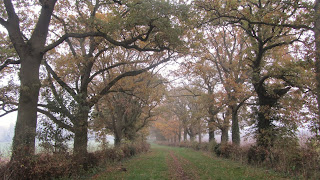Starting point today is outside the Church of St Mary the Virgin at Little Harrowden. It's walk no:134 on the Northamptonshire Walks website.
The walk will take in four local villages that I am well used to cycling around, but not so familiar with the footpaths.
There has been an overnight frost but the skies are clear blue and the sun is out. We are good to go!
 |
Little Harrowden & its neighbour Great Harrowden are the wrong way round, as Great Harrowden is a much smaller village with a population of only 161.The footpath is at the side of the church next to the school. We are soon out onto fields with views towards our next stop Orlingbury.
As the path goes further downhill the muddier it gets. We just about stay on our feet thankfully.There is still some frost patches in the shade of the hedgerows.
The footpath gradually climbs and we are next to the grounds of Orlingbury Hall. There is a herd of deer visible through the hedge.
Some smashing views looking back! The path takes us into the lovely village of Orlingbury. I've spent a bit of time here previously with the drama group at the Village Hall. It does seem a fun village with a lot going on and a good social scene.
There seems to be a lot of repair work going on at the moment too. Both the Church of St Mary and the local pub 'The Queens Arms' are both having a serious renovation. According to local folklore, the man who killed the last wolf in England is buried in the church. He is known locally as Jock of Badsaddle.
Sadly there is no trace any longer of the deserted village of Wythmail which formerly lied within the parish of Orlingbury.
We make a small detour around the splendid village green taking in the church. I'm pleased to see another telephone box has been converted into a book depository too.
We make our way out of the village looking for a footpath on the left that will take us towards Pytchley with any luck.
The path split in two directions, the one across the middle of the field was extremely muddy. So we followed the hedge down to the spinney. We could see the stream but there was no way of crossing. So in true Bear Gryll's style we hacked through the undergrowth until a clear path emerged.
It was only looking back from the path that crosses the stream we saw where we should have walked. It was the path through the middle of the field. On the brow of the hill another group og intrepid walkers were carefully navigating there way down the field.
The drama is far from over as we cross the stile in a field of cows. One in particular that looked nothing like the others tried to make a bit of a name for herself. The cow in question was all white whereas the other cows were a mixture of black and white.
It was certainly showing us some close attention and had to be shooed away. The next field was just so muddy we ended up walking around the perimeter which was still bad enough. It was a welcome relief to actually get on the hard surface of the road and into Pytchley.
We walked past the pub 'The Overstone Arms' slightly confusing as we are not in Overstone. A helpful man walking his dog sees me reading the map and offers some advice. Apparently the landowner of the path we wanted doesn't like walkers. There are other choices that lead to Isham. As it is a permissive path I have no qualms sticking to the planned route.
Thankfully none of the gates we had to pass through were locked and progress was smooth and unchallenged. More horses in the field and some lovely views looking back.
 | ||||
I think It's a case of keeping mud off the road that connects to some big industrial silos. Probably chickens being kept judging by the stench being omitted.
More fields and stiles before we reached the backs of some houses in Isham. We follow the path by the cemetery that took us to the main road. We walk along the very busy main road passing the church and a used cars sales operation.
We get off the road at the earliest point and skirt the edge of the field until we find the footpath sign. A much safer option and less noisy than taking the road route. We head towards the spinney in the distance.
 |
The next footpath is much more obvious and takes us in an uphill direction.The sun is shining through one particular avenue of tress and looks quite spectacular.
A little further on we come across a deserted barn which I believe is know as 'Frisby Lodge'. Looking beyond the old barn there are a number of wind turbines all in a line. They aen't really my cup of tea but on a day like today they look uite spectacular.
We follow the path all the way back to the road that leads to Little Harrowden and back to the car.
Certainly a challenging walk due to the condition underfoot. Very enjoyable though and a total distance of just over 7 miles.
 |































































